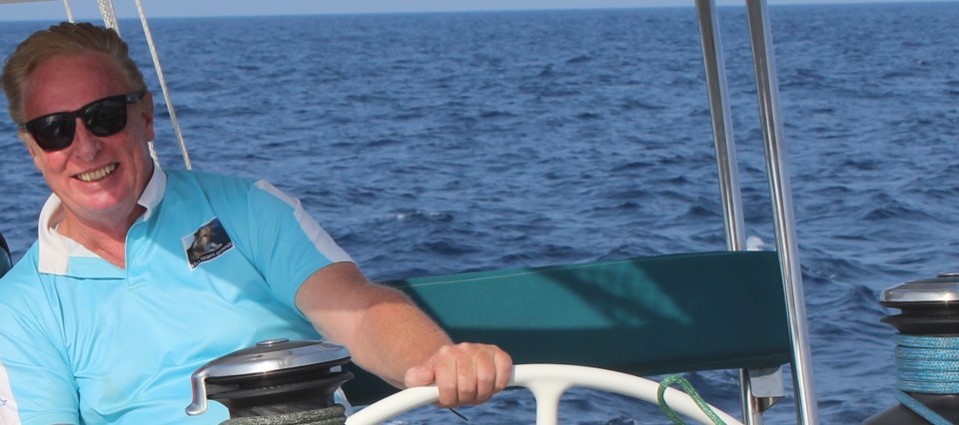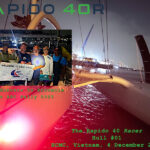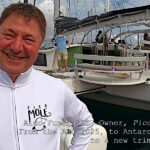“Why put up with such nonsense?”, asked Ineffable’s owner
“I remember sliding barefoot across the deck of an 82′ monohull (and I asked), ‘Why put up with such nonsense?’ “.
And so, two years ago, Stephen Bourne purchased his beloved Rapido 60, Ineffable. Below in this article, Steve who is a very well-rounded sailor, shares his reasoning as to why the Rapido 60 has been such a standout choice for him. But first, a bit of background on the man.
Steve’s background in sailing started at 9 years when he sailed dinghies, ranging from Gulls to Merlin Rockets to Javelins before settling on a long-term relationship with the original Sportsboat, the Flying 15. Eventually he bought a Magic 25 which is like a Melges 24 but with three trapezes. Steve has always erred on the side of speed side… And, oh yes, he’s also sailed a Dart 18!
In terms of big boats, he sailed a series of Intrigue boats, all about 40′, and later Freefire, the original Pyewacket of Roy Disney fame, for a few years. This included several races from Hong Kong to the Philippines; the China Coast Cup and other major regattas.
Other experiences included setting up the match racing association in Hong Kong and a very successful Asia Pacific Sportsboat Championships that attracted many world, Asian and national champions. Finally, Steve won Best Asian Regatta for his race officering of three China Coast Cups.
So, why did Steve choose a Rapido 60?
1. Crew
The biggest issue on any yacht is finding crew and keeping them. On Freefire, this could be anything up to 24 people, many of whom were simply “rail meat”. Luckily, on the 40 footers, everyone got to do something but the pure logistics of getting everyone there on time was hard work. I know most owners’ secretaries were rushed off their feet getting this done each week.
Also, with that number of people, there is always the dynamics to consider – and I am hopeless at that!
On a Rapido 60, thankfully, you don’t need so many crew. For example:
- For a cruise between islands here in the Caribbean, say a 50-mile trip, it will take around four hours and you can sail two-up; but no kites. Anchoring or picking up a mooring ball is easy.
- For a passage race with kites, you need four.
- For Round the Cans, 6-7 people is good.
- If you are entertaining or perhaps just doing an evening fun race, you can take 20 in comfort as they find spots all around the boat.
The crew are happy!
If the conditions are wet and windy, the crew can stay dry in the centre of the boat which also offers shade for when it’s hot. In colder climes, our sister boat in New Zealand, Romanza, has a perfect awning to keep the helm station dry in all conditions.
Two months ago, Romanza won a 230nm winter race in tough conditions – and the crew were served a roast dinner of lamb shanks while racing. The other entrants, meanwhile, were eager to get ashore to be warm. For them, sitting on a rail in the cold and wet – or roasting in a scorching sun – really can’t be considered that much fun, can it??
So, the Rapido 60 offers two big advantages for crew:
- The excitement of sailing upwind at over 12 knots and downwind up to 30 knots means there is no shortage of takers!
- They are always comfortable. If it is rough, they simply go below deck and enter a surreal world that is so peaceful and is as safe as it feels.
2. Cruising
The boat is ideally set up for two couples, each with a staterooms and its own head.
The boat can sleep up to eight.
In addition, Rapido now offers an enclosed cockpit so that the whole cockpit and saloon area merge to become one interior, multipurpose space that can be used as a third private cabin, extra lounge or study.
3. The big question… marina fees?
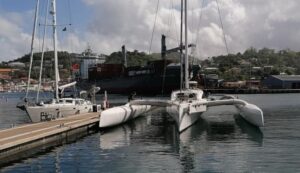
Yup it’s a big boat. The marina fees can be high. However, in my two years of owning Ineffable, I have spent only five months in a marina – and that was because I had to go home for various reasons. While away, I took two full berths for US$2,000 per month (Editor’s note: an increasing number of marinas are becoming multihull-friendly. In the heart of Genoa in Italy, the fees were only 900 EUR and the same in Las Palmas Gran Canaria).
The rest of the time, I have either been at anchor or on a mooring ball which, irrespective of the size of the boat, the fees don’t change. Typically, a mooring ball costs US$10 a day. If you take the average of all that over the two years, it’s just a few bucks a day.
Additionally, with a retractable daggerboard and rudder, you also have an option to safely come really close to a beach with a stern anchor out. And that is just wonderful!
4. Safety
Ok, it is very powerful boat. To give you an idea, a TP52 has a righting moment of about eight tons. A Rapido has a righting moment of, get this… 55 tons! So that’s seven times greater. Upwind, you are planing at 12 knots. At 15 knots, the lift is just incredible. I have never yet buried a hull.
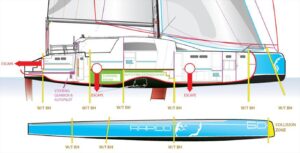
The second major design advantage for cruising is that the daggerboard and rudder are in the middle of the centre hull. So, if you lift the board and main hull any distance, the hulls just skid sideways.
Once, I had an inexperienced driver on board and we had a 35-knot gust with main and jib up. He tried to bear off and the boat did a perfect quarter circle up to head to wind. It really skids! In fact, you can do 6 knots sideways through a mooring which is always a laugh as everyone believes you will hit them… You just go forwards and backwards to miss them!
All of the heavy equipment including the anchor chains, fuel and water tanks and engine, are positioned in the middle of the boat with the daggerboard. Centering the weight makes the boat so stable. It also leaves each end of the centre hull as light as possible and it is exactly this attention to detail that makes the boat so special to sail.
Unlike monohulls, you are not dragging tons of lead keels around the world which helps to make the boat simply unsinkable (remember, the Rapido 60 has 14 watertight bulkheads and is constructed with carbon foam sandwich). How safe is that!
While the boat is particularly safe, under race conditions or when it’s blowing particularly hard, prudence dictates that everyone up front wears full lifejacket and harness.
5. Handling
The boat is very well balanced. If you are getting near the edge, the helm will get heavy so you have fair warning to depower.
The true joy of the boat is that it sails like a very stable, level, monohull. On a tack, your speed drops to about 4.6 knots. The jib is self-tacking. You do not need to back the jib. Gybing is easy as you are close to wind speed so there are no horrible crashes and bangs.
I should say it sails like a monohull on steroids!
6. Storage
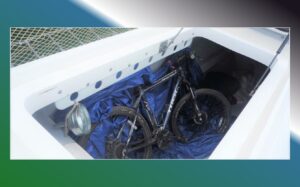
While the front and back of the floats are buoyancy tanks (further contributing to the boat’s unsinkable credentials), the watertight centre portion is for dry storage (4m in length!). This is ideal for storing sails (mould-free!), fenders and, simply, all of the stuff that you don’t use on a daily basis. There is also another, enormous, walk-down storage area under the cockpit for provisions or what ever!
The abundance of storage space ensures that the main hull is not cluttered up with boat things (yet!) and free of clutter, you have real room to breathe on the main hull.
I almost forgot about this storage space as this is such an intrinsic part of the boat.
7. Maintenance
Recently, a mate who was helping his wife complete her Yachtmaster’s Offshore course, asked if he could use the engine room (yes, room; not a cramped space!) to teach her everything about maintenance. They were there for the day which is a testament to the space and its ease of access. This is such a big plus.
A summary of the Rapido 60’s strengths
- Upwind, you are usually at wind speed and we race with a full rig, up to 25 knots. Typically, you top out at between 12.5 and 15 knots as your VMG goes haywire. You are doing 17 degrees apparent wind angle. The jib is close to centre line. Basically, you leave 100′-130′ monohulls in your dust (or sea spray).
- Downwind, anything up to 30 knots – but 30 knots is not so easy to achieve. We have usually topped out at 28.4 knots. The thing is that at those speeds, the boat glides along with huge lift from the floats and you just gently play the waves. You don’t ride them down as you may hit a big number but then have to work off 10 knots to get back up to speed.
- Your crew are safe and happy!
- You feel safe as you have incredible visibility from the helm seat. You are high up so can see close to the boat including all four corners. The Rapido 60 also turns on a sixpence, like a monohull!
- You sail at up to 15 degrees heel (usually 5–10 degrees) and are flat on a mooring. This means its easy to cook while you are sailing and, in heavy conditions, your crew is not hanging on for dear life! I recently sailed an 82′ Swan and had completely forgotten how uncomfortable it is to sail with a heel of 35+ degrees. I remember sliding barefoot across the deck… Why put up with such nonsense!
And for one final strength, it’s half the price of a Gun Boat – and we give them a good run for the money!

